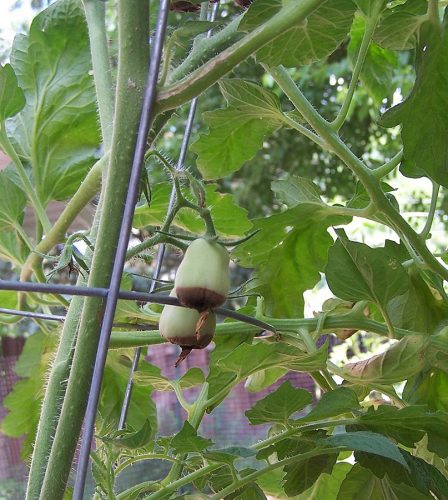Calcium deficiency is not common; a deficiency causes low pH, i.e., acidic soil.
Also known as:
Blossom end rot
Bitter pit (apple)
Internal browning (apple)
Do not confuse with:
Potassium deficiency
Calcium deficiency is not common. Calcium lends the plant its firmness and regulates pH. Excess calcium raises the pH in the soil, reducing the ability of plants to absorb nutrients. The less calcium the more acidic (pH 7.0) the soil. Some plants thrive in somewhat acidic soil, such as heather.
Plants absorb calcium and rain and groundwater wash away calcium: calcium slowly disappears from the soil making it acidic. Fertilizers with agricultural lime replenish the amount of calcium.
Calcium deficiency manifests itself in several ways: in lettuce, cabbage and sprouts, tipburn occurs, the edges of the leaves yellowing and turning brown.
Calcium deficiency causes blossom end rot in tomatoes and peppers as well as ‘bitter pit’ in apples: around the core of the apple, glassy, translucent spots appear in the flesh: the cells leak cell fluid. The taste of those spots is bitter.
Some apple varieties are prone to bitter pit: including Bramley apples.
Where to find
- Vegetable plot and ornamental garden
- Cabbages
- Apple tree
- Lettuce
- Brussels sprouts
- Tomato, paprika, pepper
Control
Damage to plants is unfortunately irreversible. Prevent further damage by restoring the calcium deficiency: provide the soil with agricultural lime or calcium-nitrate. Aim for a pH of 6.5.
Prevention
At the end of winter, check the pH level of the soil: if it is too low, sprinkle agriculturale lime or fertilize with a calcium-enriched fertilizer. Aim for a pH of 6.5 (very slightly acidic, in other words). Most plants thrive in it.
In professional fruit growing, calcium nitrate (also called Norwegian salpeter) is sprayed preventively on apple varieties that are sensitive to bitter pit.

